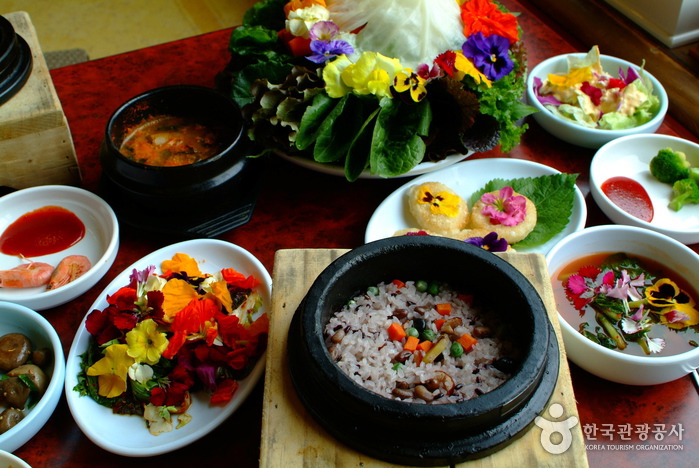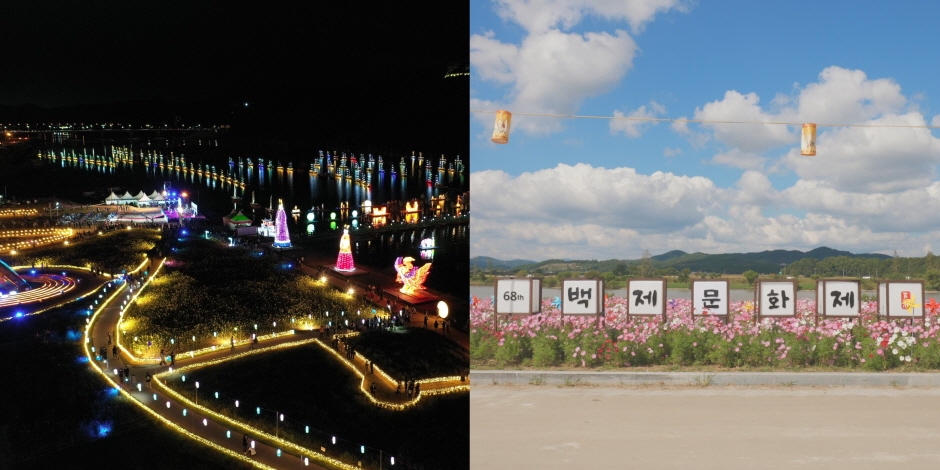Himart - Gongju Branch [Tax Refund Shop] (하이마트 공주점)
18.7Km 2024-04-18
51, Beonyeong 1-ro, Gongju-si, Chungcheongnam-do
-
Guard-Changing Ceremony of Woongjinseong Fortress (웅진성수문병 근무교대식)
18.8Km 2022-12-21
280, Woongjin-ro, Gongju-si, Chungcheongnam-do
• 1330 Travel Hotline: +82-2-1330 (Korean, English, Japanese, Chinese) • For more info: +82-41-856-7700
The Guard-Changing Ceremony of Woongjinseong Fortress takes place at Gongsanseong Fortress, a part of the Baekje Historic Areas which is a desginated UNESCO's World Heritage Site. The ceremony reenacts the service of the guards defending the castle, using costumes and props based on the strict analysis of the historical records. The ceremony is held every Saturday and Sunday from April to November except during hot summer season of June to August, and conducted every day during the Baekje Culture Festival in the fall. The event includes martial art performances and various experiences as well as the main ceremony, aiming at promoting Gongju-si, where the Baekje culture flourished, and its valuable heritage Gongsanseong Fortress.
Gomanaru 1999 (고마나루1999)
18.8Km 2024-02-28
5-8 Baengmigoeul-gil, Gongju-si, Chungcheongnam-do
+82-41-857-9999
Gomanaru 1999 is a Korean restaurant located near Gongsanseong Fortress. Their menu features a single set meal called gomanaru bapsang (rice and side dishes), which includes a hearty spread of pot rice, boiled pork slices, grilled marinated pork shoulder, and grilled dried pollack. Using rice from Gongju, the rice is flavorful and nourishing, complemented by fresh vegetables from Jirisan Mountain, making for a healthy meal. Rice is considered a staple in Korean cuisine, and Jirisan Mountain is renowned as a pristine region, making the food here particularly special.
Baekje Cultural Festival (백제문화제 )
18.9Km 2024-07-17
368 Geumbyeok-ro, Gongju-si, Chungcheongnam-do
Gongju: +82-41-840-8090 Buyeo: +82-41-830-2208
Baekje Cultural Festival first started in 1955 and aims to bring the history and culture of the Baekje era to life, taking place at UNESCO-recognized sites throughout Gongju and Buyeo.
Mireuseom Island (미르섬)
18.9Km 2023-10-27
368 Geumbyeok-ro, Gongju-si, Chungcheongnam-do
Mireuseom Island is covered in a blanket of beautiful plants every fall, from cosmos to pink muhly, broom cypress and pearl millet. The pink muhly growing along the Geumgang River is a popular photo spot. The beautiful landscape unfolds the longer you walk towards Gongjudaegyo Bridge.
HONG WHI KWAN[Korea Quality] / 홍휘관[한국관광 품질인증/Korea Quality]
18.9Km 2020-11-19
6-6, Baengmigoeul-gil, Gongju-si, Chungcheongnam-do
+82-10-9701-3141, +82-41-858-8890
Located in Gongju, South Chungcheong Province, Hongwhikwan offers guests a traditional “hanok” experience filled with the gentle scents of red clay and wood. The hotel is located in front of the UNESCO World Heritage site Gongsanseong Fortress, with Geumgang River flowing behind the complex.
There are six rooms in total, all Korean-style with floor bedding for double, triple, and quadruple occupancy. High ceilings and exposed girders greet visitors upon entering the rooms that are decorated with traditional bedding, Korean paper windows, elegant muslin curtains, and colorful cushions. Each room is equipped with a TV set, a refrigerator, and a bathroom with a hairdryer, making it an ideal place to start and end the day. The spacious courtyard also comes with traditional games like “jegi chagi” and “yutnori.” Coffee and Korean tea are found in the second-floor community room, while the kitchen serves complimentary breakfast every morning with a simple menu of toast, beverages, fruits, and breakfast cereals. Furthermore, the complex is close to major tourist sites, such as the Gongjusanseong Market, Gongju National Museum, the UNESCO World Heritage site Ancient Tombs in Songsan-ri, and Tomb of King Muryeong. Hongwhikwan also offers free bicycle rentals for guests to stroll around the location.
Gongju Tomb of King Muryeong and Royal Tombs [UNESCO World Heritage] (공주 송산리 고분군과 무령왕릉 [유네스코 세계문화유산])
19.3Km 2024-01-08
37-2 Wangreung-ro, Gongju-si, Chungcheongnam-do
The Songsan-ri Tombs and Royal Tomb of King Muryeong (r. 462-523) contain representative relics of the Baekje period (234-678). The Songsan-ri Tombs contain the graves of kings from the period when Baekje's capital was Gongju, and it is believed to contain 17 such graves. Only seven graves have been discovered so far. There are two types of tomb designs: traditional Baekje-style rock and earth fortification tomb and Chinese-influenced rock tomb. The tombs number one to five were made using the traditional Baekje-style design while tomb number six and the Royal Tomb of King Muryeong were made using the Chinese-influenced design. Even though many artifacts were stolen from the tombs, the tombs serve as an important evidence of Baekje culture and the foreign exchanges from during that period.
Donamseowon Confucian Academy [UNESCO World Heritage] (돈암서원 [유네스코 세계문화유산])
19.5Km 2021-06-22
26-14, Im 3-gil, Nonsan-si, Chungcheongnam-do
+82-41-736-0096
Donamseowon Confucian Academy was built in 1634, originally 1.5 kilometers away from its current location. It received a royal charter in 1660 and relocated to its current location in 1880 due to flooding problems. The academy's main gate, Ipdeokmun Gate, is made up of three entrance doors. Once inside, Yangseongdang Hall can be seen facing the main gate, with Eungdodang Hall to the left. Ancestral rites take place every February and August at Jungjeong Hall. Inside the academy is a shrine that houses the ancestral tablets of four prominent scholars who taught at this institution - Kim Jang-saeng, Kim jip, Song Jun-gil, and Song Si-yeol. Among the academies that served Kim Jang-saeng and his teachings, Donamseowon is considered the most important and influencial.
Baekje Experience Center (백제오감체험관)
19.5Km 2024-01-08
30 Gomanaru-gil, Gongju-si, Chungcheongnam-do
The Baekje Experience Center offers a rich array of activities that allow visitors to engage with the history they have observed at the nearby ancient tombs in Songsan-ri and the Gongju National Museum in a tactile manner. This center features eight themed halls across the first basement, and the first and second above-ground floors, offering interactive and gaming programs designed to stimulate all five senses. Activities such as rubbing pattern experience and luminous stamps allow visitors to learn about and appreciate the culture and history of Woongjin Baekje in an intuitive way. One of the center’s highlights is the Window of Sympathy in the first-floor lobby. This impressive two-story panel changes its color in response to sound and touch, promising to attract significant attention from tech-savvy visitors. It showcases content that guests have captured within the center and shared on social media, complete with hashtags. Additionally, the Window of Creation on the same floor offers a unique creative outlet. Here, visitors can color Baekje-era relics with crayons. These artworks are then transformed into graphic mapping images on the wall via a scanner, allowing for a personalized and immersive historical experience.
Gujeolsa Temple (구절사)
19.6Km 2024-02-26
226, Sangjung-gil, Gunseo-myeon, Okcheon-gun, Chungcheongbuk-do
Gujeolsa Temple is a Buddhist temple located deep within the Sikjangsan Mountain in Okcheon. It was founded in 1393 and was rebuilt in 1933 to its present appearance. The road from the radio tower fork to Gujeolsa Temple in Sikjangsan Mountain’s hiking trails is lush with acacia trees, which are in full bloom in May. Another sight that should not be missed is the fog shrouding the foot of the mountain in spring and fall.
![Himart - Gongju Branch [Tax Refund Shop] (하이마트 공주점)](http://tong.visitkorea.or.kr/cms/resource/43/2883343_image2_1.jpg)



![HONG WHI KWAN[Korea Quality] / 홍휘관[한국관광 품질인증/Korea Quality]](http://tong.visitkorea.or.kr/cms/resource/57/2651357_image2_1.jpg)
![Gongju Tomb of King Muryeong and Royal Tombs [UNESCO World Heritage] (공주 송산리 고분군과 무령왕릉 [유네스코 세계문화유산])](http://tong.visitkorea.or.kr/cms/resource/95/2678695_image2_1.jpg)
 English
English
 한국어
한국어 日本語
日本語 中文(简体)
中文(简体) Deutsch
Deutsch Français
Français Español
Español Русский
Русский